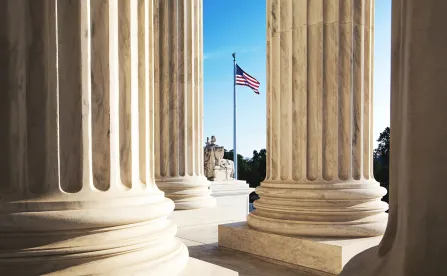Guam v. United States, No. 20-382 (May 24, 2021)
In siding with the Territory of Guam in its dispute with the United States over costs to clean up the Ordot Landfill, the Supreme Court has resolved a circuit court split over which types of administrative settlements trigger contribution rights under the Comprehensive Environmental Response, Compensation and Liability Act (CERCLA). The Court’s unanimous opinion in Territory of Guam v. United States, written by Justice Clarence Thomas, provides important guidance for parties that have entered into consent agreements and other regulatory settlements and are seeking to recover response costs from responsible parties. The case also discusses important distinctions between CERCLA causes of action and the applicable statute of limitations for each.
CERCLA offers two potential remedies for parties seeking to recover a portion of their response costs from other responsible parties. Section 107(a) provides for “cost recovery,” entitling claimants to recover their response costs from a responsible party without first demonstrating liability to a third party. The statute of limitations for cost recovery claims is (i) within three years after completion of a removal action; or (ii) within six years after initiation of physical on-site construction of a remedial action. Alternatively, Section 113(f)(3)(B) allows a party that has “resolved its liability to the United States or a State . . . for some or all of a response action or for some or all of the costs of such action in [a] settlement” to seek contribution from other responsible parties. The statute of limitations for a contribution action under Section 113 is within three years from the date of the underlying judgment. While liability under Section 107 is joint and several, a contribution claim under Section 113 involves only several liability. As a result, a contribution claim among responsible parties involves an equitable allocation of response costs, with each party responsible only for its equitable share. As the Supreme Court held in Atlantic Research, cost recovery and contribution are separate causes of action, available to parties in different procedural circumstances. A party that settles with the government may pursue a contribution claim against other responsible parties, which is “contingent upon an equitable distribution of common liability among liable parties.” U.S. v. Atlantic Research Corp., 551 U.S. 128, 139 (2007). A cost recovery action, on the other hand, “permits recovery of cleanup costs but does not create a right to contribution” because a “person may recover under 107(a) without establishment of liability to a third party.” Id.
This interplay between Sections 107 and 113 played out in Guam’s decades-long dispute with the United States over costs incurred by Guam in remediating the Ordot Landfill. Beginning in the 1940s, the United States Navy used the 23-acre landfill to dispose of hazardous waste, including munitions and chemicals. Guam assumed landfill operations in the 1970s and continued to use the Ordot site until its closure in 2011. In 2002, after decades of what the United States alleged was expanded operations and poor environmental management, the Environmental Protection Agency (EPA) sued Guam for permit violations under the Clean Water Act (CWA). The parties settled the CWA claims in 2004 in a consent decree that required the Territory to close and remediate the Ordot site. After incurring more than $160 million in response costs, Guam brought a CERCLA action against the Navy in 2017, claiming both cost recovery under Section 107 and contribution under Section 113(f)(3)(B). In its response, the United States argued that (i) Guam’s contribution claim was triggered upon the entry of the 2004 consent decree; (ii) the claim was time-barred by the three-year statute of limitations for contribution actions; and (iii) Guam’s cost-recovery claim could not stand, as the contribution claim was the Territory’s exclusive CERCLA remedy. The District Court ruled in Guam’s favor, holding that the 2004 consent decree did not explicitly resolve the Territory’s CERCLA liability, and therefore was not a “settlement” within the meaning of Section 113(f)(3)(B). In the absence of a “settlement” triggering contribution rights, the Court allowed Guam’s cost recovery claim, filed in the alternative, to proceed.
On appeal, the D.C. Circuit reversed, finding that the 2004 consent decree, which had resolved the United States’ claims under the CWA, also resolved Guam’s liability for some response actions under CERCLA, and therefore constituted a “settlement” within the meaning of Section 113(f)(3)(B). Guam v. United States, 950 F.3d 104 (D.C. Cir. 2020). As a result, the Appeals Court found that (1) the Territory’s contribution rights had been triggered through entry of the 2004 consent decree; (2) recovery under Sections 113 and 107 is mutually exclusive, leaving Guam to proceed only with contribution under Section 113; and (3) since the contribution claim expired in 2007, Guam’s only viable CERCLA claim was time-barred. The Circuit Courts of Appeal had been divided on the issue of whether a settlement agreement that does not explicitly resolve CERCLA claims, such as Guam’s consent decree with the EPA that resolved claims under the CWA, creates contribution rights under Section 113. The Second Circuit stood alone in concluding that such resolutions do not constitute a “settlement” for purposes of CERCLA contribution claims. In rejecting Guam’s claims, the D.C. Circuit sided with the Third, Seventh, and Ninth Circuits, holding that non-CERCLA settlements can give rise to Section 113 claims.
The Supreme Court granted Guam’s petition for certiorari, and argument was held on April 26, 2021. Just four weeks later, on May 24, the Court issued its unanimous opinion, holding that contribution rights under CERCLA do not arise until and unless there is a resolution of a CERCLA-specific liability. Settlements that resolve liability under other environmental laws, such as consent orders pursuant to the CWA, the Resource Conservation and Recovery Act (RCRA), or the Toxic Substances Control Act (TSCA), are not sufficient. That is so even when the costs that arise under such a consent order result in a party incurring CERCLA-like response costs. In Guam’s case, for example, the CWA consent order resulted in the Territory incurring response costs to close and remediate the Ordot Landfill – work that essentially would be the same for a settlement under either the CWA or CERCLA. Notwithstanding the similarity of the response costs incurred, the Court noted that the CWA consent decree did not resolve potential CERCLA claims that could be brought against the Territory. The Court rejected the United States’ argument that the term “response action” as used in Section 113(f)(3)(B) was broad enough to encompass non-CERCLA liabilities. “To be sure, as the Government points out, remedial measures that a party takes under another environmental statute might resemble steps taken in a formal CERCLA ‘response action.’ But relying on that functional overlap to reinterpret the phrase ‘resolved its liability . . . for some or all of a response action’ to mean ‘settled an environmental liability that might have been actionable under CERCLA’ would stretch the statute beyond Congress’ actual language.” Territory of Guam v. United States, No. 20-382, slip op., at 4-6 (May 24, 2021). The Court went on to state, “[i]t would be rather odd to say that a party has ‘resolved its liability’ if that party remains vulnerable to a CERCLA suit. All the more so given that it will not always be clear whether the substance of a prior environmental settlement was sufficiently similar to a quasi-CERCLA ‘response action.’” Id. Rather than have parties parse through the scope and specific provisions of the administrative settlement to determine whether it gives rise to a contribution action, the Court offered “the far superior approach” of simply asking whether the settlement expressly discharged a CERCLA liability. Id., If the answer is “no,” contribution rights have not been triggered. With the dismissal of the Territory’s contribution claim, the case was remanded to the District Court for further proceedings on Guam’s cost-recovery claims under Section 107.
Despite losing its contribution claim, Guam is the prevailing party, as the Court’s holding potentially restores the Territory’s previously dismissed cost recovery claim. Depending on the facts of a given case, the holding in Guam v. United States could favor or disfavor the rights of both CERCLA claimants and defendants. The ruling could adversely affect a claimant seeking to recover response costs through a contribution action premised on a settlement that addresses non-CERCLA liabilities. That party must then consider the availability of cost recovery under Section 107. Alternatively, parties facing contribution claims allegedly triggered by an administrative settlement may have a valid defense. It is reasonable to anticipate that future administrative settlements will clearly state what liabilities are discharged.
The Court did not squarely address the exclusivity of claims under Sections 107 and 113. The final word on whether a party to a CERCLA settlement is limited to contribution under Section 113, even if a cost-recovery claim under Section 107 would otherwise be available, will have to wait for another day.



 />i
/>i

